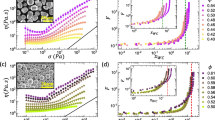Abstract
We describe a new, effective medium theory to study the wave propagation and mechanical properties of a composite system with dispersed particulates. One main emphasis here is in formulating the theory and in analyzing the structure of the contribution of the fillers to the elastic response. By constructing the elastic propagator (whose fluid mechanical counterpart is known as the Oseen tensor), we show that an analogy between the theoretical description of the particulate system and of suspension rheology exists when the former corresponds to a high-rigidity solid matrix (or, analogously, when the Poisson ratio is close to 1/2) in steady state. The effective Lamé constants for this case are derived by combining this analogy with the theory developed by Freed and Muthukumar for the rheology of a suspension of spheres. The analogy is also useful in our new prediction of the phenomenon of elastic screening, the possible existence of a cutoff frequency below which elastic waves cannot propagate in the filler system.
Similar content being viewed by others
References
J. C. Seferis and L. Nicolais, eds.,The Role of Polymer Matrix in the Processing and Structural Properties of Composite Materials (Plenum Press, New York, 1983).
L. E. Nelson,Mechanical Properties of Polymers and Composites (Marcel Dekker, New York, 1974).
K. F. Freed and M. Muthukumar,J. Chem. Phys. 68:2088; M. Muthukumar and K. F. Freed,J. Chem. Phys. 70:5875 (1979).
K. F. Freed and S. F. Edwards,J. Chem. Phys. 61:3626 (1974);62:4032 (1975); A. Perico and K. F. Freed,J. Chem. Phys. 86:5830 (1987); A. Perico, R. LaFerla, and K. F. Freed,J. Chem. Phys. 86:5842 (1987).
A. Einstein,Ann. Physik (Leipzig)19:289 (1906);34:591 (1911).
Z. Hashin,Bull. Res. Counc. Israel 5C:46 (1955); Z. Hashin,J. Appl. Mech. 29:143 (1962).
J. N. Goodier,Trans. ASME 55:39 (1933); J. Rehner, Jr.,J. Appl. Phys. 14:638 (1943).
E. Guth and O. Gold,Phys. Rev. 53:322 (1938); E. Guth, inProceedings of the Fifth International Congress of Applied Mechanics (Cambridge, 1938), p. 448; E. Guth,J. Appl. Phys. 16:20 (1945).
S. Feng and P. N. Sen,Phys. Rev. Lett. 52:216 (1984).
P. Pathak, H. T. Davis, and L. E. Scriven, inMechanics of Structured Media, A. P. S. Selvadurai, ed. (Eisevier, 1981), pp. 268–284.
W. Y. Hsu, M. R. Giri, and R. M. Ikeda,Macromolecules 16:1210 (1982); W. Y. Hsu and T. Berzins,J. Poly. Sci. Poly. Phys. Ed. 23:933 (1985).
G. A. Campbell, AIChE Symposium Series, Presented at Washington AIChE Meeting (November 1983).
J. R. Banavar, J. Koplik, and K. W. Winkler, eds.,Physics and Chemistry of Porous Media II (American Institute of Physics, New York, 1987).
L. D. Landau and E. M. Lifshitz,Theory of Elasticity (Pergamon, London, 1959).
D. A. McQuarrie,Statistical Mechanics (Harper and Row, 1976).
P. G. DeGennes,Macromolecules 9:587, 594 (1976).
C. Y. Mou and S. A. Adelman,J. Chem. Phys. 69:3155, 3146 (1978).
M. Muthukumar and K. F. Freed,J. Chem. Phys. 76:6195 (1982).
M. Muthukumar and K. F. Freed,J. Chem. Phys. 78:497, 5112 (1983).
M. S. Jhon, R. Metz, and K. F. Freed,J. Chem. Phys., submitted. '
Author information
Authors and Affiliations
Additional information
Research supported by ALCOA and MRL (NSF) facilities at The University of Chicago.
Rights and permissions
About this article
Cite this article
Jhon, M.S., Metz, R.J. & Freed, K.F. Effective medium theory for elastic matrix composites containing dispersed particulates. J Stat Phys 52, 1325–1342 (1988). https://doi.org/10.1007/BF01011650
Received:
Issue Date:
DOI: https://doi.org/10.1007/BF01011650




